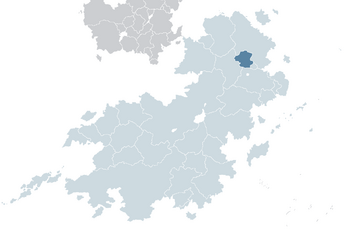Nahrun
Nahrune Council Republic جمهوری شورای دریاچه کاذب (Pardarian) Jmhwra Shwraa Draacheh Keadb | |
|---|---|
| Motto: Unity, Struggle, Progress اتحاد، مبارزه، پیشرفت | |
| Anthem: Arise, workers! برخیزید کارگران | |
 Location of Nahrun in Coius | |
| Capital and largest city | Balad Alfil |
| Official languages | |
| Demonym(s) | Nahrune |
| Government | Federal socialist council republic |
List
| |
| Thomas N'Doram | |
| Jurg Ochsner Kebzabo | |
| Ochola Oduya | |
| Kenneth Oneko | |
| Legislature | National Assembly |
| Independence from Estmere | |
• as the Kingdom of Nahrun | 30 April 1951 |
• Monarchy abolished | 2 December 1973 |
• Nahrune Council Republic established | 1 January 1979 |
| Area | |
• Total | 365,658 km2 (141,181 sq mi) |
| Population | |
• 2021 estimate | 5,675,299 |
• Density | 15.52/km2 (40.2/sq mi) |
| GDP (PPP) | 2021 estimate |
• Total | €7.798 billion |
• Per capita | €1,374 |
| GDP (nominal) | 2021 estimate |
• Total | €3.331 billion |
• Per capita | €587 |
| Gini (2021) | 44.3 medium |
| HDI (2021) | 0.400 low |
Nahrun, officially the Nahrune Council Republic, is a landlocked country located in west Bahia. It is bordered by Asase Lewa in the northest, Tiwura to the east, Yemet to the south, and Behera to the west. With an estimated population of 5,675,299, it is the smallest country in Bahia in terms of population. It is also the smallest country in Bahia by area, covering an area of 365,658 square kilometers (141,181 sq mi). Its capital and largest city, Balad Alfil, has traditionally been at the crossroads of various empires and civilizations from Rahelia and Bahia.
Nahrun was an early center of human civilization populated by Gondiatic peoples since the third millennium. Human settlement has mostly been concentrated in the tropical savanna climate located in the southern regions of the country. Portions of present-day Nahrun were part of various Bahian empires, most notably the Kamaba Empire. After the 11th century, the region was conquered by Irfanic empires and split between them, with several rulers laying claim to the area and control being disputed. It was considered a frontier region. Many Bahian cultural institutions, such as Hourege, were never successfully established. During Toubacterie, Nahrun came under Estmerish control. It was administered as part of the Estmerish Viceroyalty of Bahia and saw little development. After the Great War, Estmere reorganized its colonies in the face of increased anti-colonial activity. The Colony and Protectorate of Nahrun was established in 194X, resulting in the country’s present-day borders.
Nahrun was granted independence alongside Asase Lewa in 1951. The Kingdom of Nahrun was established as an absolute monarchy, maintaining some elements of the constitution drafted by the Estmerish for the colony. King Raila became the first and only monarch of Nahrun. Corruption, authoritarianism, extreme poverty, and ethnic fighting resulted in the outbreak of civil war in 1967. The socialist Nahrune People's Revolutionary Front fought the government, backed by Estmere, for several years with Asalewan and socialist backing. The conflict lasted until 1973 when the royalist government surrendered. The republic Nahrune Workers’ Republic was established. After several years of state-building with Asalewan support, the government declared that a councilist state had been established and the country became officially known as the Nahrune Council Republic in 1979. The country has maintained strong ties with Asase Lewa since the end of the civil war and has also built deepening ties with Dezevau, Shangea, and Zorasan. Starting in 2014, Irfanic groups within the Masa launched an insurgency against the government. The conflict remained active until 2017, when it effectively became frozen.
Social indicators have improved since the early 2000s, but Nahrun still remains one of the poorest countries in the world. It is highly reliant on foreign aid from other socialist countries and Coian states. The country is ethnically diverse with over 50 ethnic groups. The main groups are Horo, Welke, Begi, Masa, and Ororo peoples. The most commonly spoken languages are Estmerish and Pardarian and both have official status, although many other languages are spoken. Nahrun is an exporter of uranium, oil, and gold alongside the traditional cotton growing industry. It is a member of the Community of Nations, AIS, CBS, and the IFDS.
Etymology
The word nahrun is Rahelian for river. It was first used to refer to present-day Nahrun by the Estmerish in the late 19th century. It was adopted by the Estmerish as a loan from Rahelian guides as they traveled the Gonda, of which nahrun is in reference to. The name was formalized in 194X when the Colony and Protectorate of Nahrun was established by the Estmerish, seperating the territory from the Estmerish Viceroyalty of Bahia. After independence, the name was formalized by the Kingdom of Nahrun and kept after the end of the civil war.
In (Pardarian), a co-official language and a lingua franca for Irfanic groups in the country, Nahrun is known as دریاچه کاذب, transliterated as Draacheh Keadb, which means "false lake". The name comes from Pardarian traders in reference to the mirage phenomenon of the Fersi desert, located in the country's north.

